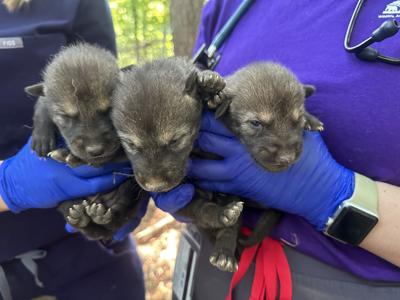NC State’s Carnivore Conservation Crew celebrated the birth of three red wolf pups on campus over Mother’s Day weekend, marking a significant milestone for NC State’s role in conservation efforts. This was the third successful litter and the largest litter in NC State’s history of participating in the Red Wolf Conservation program.
The red wolf, a species native to North Carolina, once ranging from New York to Texas, now numbers fewer than 30 in the wild. Due to habitat loss, hunting and hybridization with coyotes, their population dwindled to near extinction by the 1970s. In an attempt to save the species, the U.S. Fish and Wildlife Service captured some of the remaining wild red wolves and established a captive breeding program that uses over 40 institutions to breed and take care of red wolves.
Tara Harrison, professor of veterinary medicine and advisor of the Carnivore Conservation Crew, said the birth of every pup is important to conservation efforts.
“This animal is so critically endangered, every single one counts,” Harrison said. “So with these puppies, there's probably around less than 300 red wolves in the world, so three more, that's a pretty big number. So we're very excited to have our part in increasing the numbers of this population.”
Harrison said NC State welcomed its first red wolves onto campus in 2001. They are cared for by the Carnivore Conservation Crew, a student-run organization with over 50 active members that is dedicated to the daily care and maintenance of the red wolf population on campus.
“We're creating through Carnivore Conservation Crew future veterinarians for wildlife and by teaching them the skills, they are not only becoming advocates of these species … but they're also going to be able to learn these skills to help conserve these species as well as others into the future,” Harrison said.
Sean Hubbard, a graduate student studying veterinary medicine and a co-president of the Carnivore Conservation Crew, said the organization’s responsibilities include feeding the wolves, administering medicine and conducting annual physicals. He said the students are careful to limit human contact, as they want to raise wolves that can be suitable for release back into the wild.
“We want them to live a life with as few humans in sight as possible,” Hubbard said. “That's why their location is very quiet and they only have students around them for maybe 15 minutes in the morning and half an hour in the evening, at most. … And if we can avoid it, they don't get touched by a human any other time during their life, and that's because we want the wolves in the wild to respect humankind from a distance.”
The University's facilities for the wolves are designed to mimic their native habitat, with multiple pens in a wooded area and den-type boxes. A separate building is used for food storage, preparation and medical procedures. Harrison said the exact location of these facilities is kept confidential to ensure the wolves' safety.
Hubbard said the conservation efforts at NC State are part of a larger network managed by the U.S. Fish and Wildlife Service and the Association of Zoos and Aquariums’ “Saving Animals from Extinction” program. This collaboration includes about 50 partners, including the Durham Museum of Life and Science and the North Carolina Zoo, both of which have also had successful wolf litters this year.
NC State’s efforts extend beyond the campus population, as the Carnivore Conservation Crew also assists with the wild red wolf population in the Alligator River National Wildlife Refuge in eastern North Carolina. This refuge is home to the only remaining wild population of red wolves.
Harrison said the reintroduction of the red wolf would not only benefit the red wolf population but also the rest of North Carolina’s native ecosystem by keeping the deer and coyote populations in check.
“Anytime you take one item out of a population, that ecosystem is damaged,” Harrison said. “So by putting the red wolf back where it belongs, it will help restore that whole ecosystem and bring it back into balance.”
Aside from caring for the wolves, Harrison said a goal of NC State’s conservation efforts is to increase awareness of the vulnerability and importance of the red wolves.
“For our role, specifically, it's more red wolves exist,” Harrison said. “They're very, very endangered and we're doing our part to try to help preserve this population. The reason they're critically endangered is because of people, so it's also because of people we’re trying to help increase it again.”



(0) comments
Welcome to the discussion.
Log In
Keep it Clean. Please avoid obscene, vulgar, lewd, racist or sexually-oriented language.
PLEASE TURN OFF YOUR CAPS LOCK.
Don't Threaten. Threats of harming another person will not be tolerated.
Be Truthful. Don't knowingly lie about anyone or anything.
Be Nice. No racism, sexism or any sort of -ism that is degrading to another person.
Be Proactive. Use the 'Report' link on each comment to let us know of abusive posts.
Share with Us. We'd love to hear eyewitness accounts, the history behind an article.